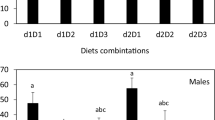Abstract
The parsnip webworm, Depressaria pastinacella, exhibits limited physiological resistance to furanocoumarin toxins in its principal host, the wild parsnip, Pastinaca sativa. These insects are typically found attacking individual plants low in furanocoumarins, relative to others within populations. They also feed preferentially on parthenocarpic fruits, which are lower in furanocoumarin content than are normal fruits. However, in a previous study with artificial diets, they did not appear to discriminate between high and low concentrations of furanocoumarins. In this study, the ability of webworms to distinguish between diets differing in furanocoumarin content was examined with an artificial diet containing wild parsnip and in green parsnip fruits with and without supplemental furanocoumarins. Larvae showed no preference for high or low furanocoumarin diets containing equal amounts of freeze-dried parsnip fruit powder. When given a choice between otherwise similar wild parsnip fruits, webworms strongly preferred fruits that were not augmented with furanocoumarins in one plant but showed no preference or only a weak preference for nonaugmented fruits in four other plants. In order to identify chemical constituents other than furanocoumarins that might determine feeding preferences, we compared the chemical profile of parthenocarpic fruits (which are preferred) to that of normal fruit. Octyl butyrate, a known deterrent to webworms, is highly correlated with furanocoumarin content, occurs in all plants, and differs significantly among normal and parthenocarpic fruit, suggesting that webworms may be able to avoid furanocoumarins by virtue of their behavioral response to octyl butyrate.
Similar content being viewed by others
REFERENCES
Berenbaum, M. R. and Neal, J. J.1985. Synergism between myristicin and xanthotoxin, a naturally cooccurring plant toxicant. J. Chem. Ecol.11:1349–1358.
Berenbaum, M. R. and Zangerl, A. R.1986. Variation in seed furanocoumarin content within the wild parsnip Pastinaca sativa. Phytochemistry25:659–661.
Berenbaum, M. R. and Zangerl, A. R.1992. Genetics of physiological and behavioral resistance to host furanocoumarins in the parsnip webworm. Evolution45:1373–1384.
Berenbaum, M. R. and Zangerl, A. R.1996. Phytochemical diversity: adaptation or random variation?, pp. 1–24 inJ. T. Romeo, J. A. Saunders, and P. Barbosa (eds.). Phytochemical diversity and redundancy in ecological interactions. Plenum Press, New York.
Berenbaum, M. R. and Zangerl, A. R.1998. Chemical phenotype matching between a plant and its insect herbivore. Proc. Natl. Acad. Sci. USA95:13743–13748.
Bernays, E. A. and Chapman, R. F.1994. Host-plant Selection by Phytophagous Insects. Chapman and Hall, New York.
Bernays, E. and Graham, M.1988. On the evolution of host specificity in phytophagous arthropods. Ecology69:886–892.
Carroll, M. J., Zangerl, A. R., and Berenbaum, M. R.2000. Heritability estimates for octyl acetate and octyl butyrate in the mature fruit of the wild parsnip. J. Hered.91:68–71.
Cianfrogna, J. A., Zangerl, A. R., and Berenbaum, M. R.2002. Dietary and developmental influences on induced detoxification in an oligophage. J. Chem. Ecol.28:1345–1360.
Huang, X. P. and Renwick, J. A. A.1997. Feeding deterrents and sensitivity suppressors for Pieris rapaelarvae in wheat germ diet. J. Chem. Ecol.232:51–70.
Nitao, J. K. and Berenbaum, M. R.1988. Laboratory rearing of the parsnip webworm, Depressaria pastinacella(Lepidoptera: Oecophoridae). Ann. Entomol. Soc. Am.81:485–487.
SPSS. 1999. SPSS 9.0. SPSS Inc., Chicago, Illinois.
Shields, V. D. C. and Mitchell, B. K.1995. Sinigrin as a feeding deterrent in two crucifer-feeding polyphagous lepidopterous species and the effects of feeding stimulant mixtures on deterrency. Phil. Trans. R. Soc. LondonB 347:439–446.
Siemens D. H. and Michell-Olds T.1996 Glucosinolates and herbivory by specialists (Coleoptera, Chrysomelidae, Lepidoptera, Plutellidae)—consequences of concentration and induced resistance Environ. Entomol.25:1344–1353.
St Ädler, E.1992. Behavioral responses of insects to plant secondary compounds, pp. 45–88, inG. A. Rosenthal and M. R. Berenbaum (eds.) Herbivores: Their Interactions with Secondary Plant Metabolites, Vol. 2. Academic Press, New York.
Verschaffelt, E.1910. The cause determining the selection of food in some herbivorous insects. Proc. Kon. Ned. Akad. Wetensch., Afd. Naturk.13:536–542.
Zalucki, M. P., Brower, L. P., and Alonso-M, A.2001. Detrimental effects of latex and cardiac glycosides on survival and growth of first-instar monarch butterfly larvae Danaus plexippusfeeding on the sandhill milkweed Asclepias humistrata. Ecol. Entomol. 26:212–224.
Zangerl, A. R. and Berenbaum, M. R.1992. Oviposition patterns and hostplant suitability: parsnip webworms and wild parsnip. Am. Midl. Nat.128:292–298.
Zangerl, A. R. and Berenbaum, M. R.1993. Plant chemistry, insect adaptations to plant chemistry, and host plant utilization patterns. Ecology74:47–54.
Zangerl, A. R. Berenbaum, M. R., and Nitao, J. K.1991. Parthenocarpic fruits in wild parsnip: decoy defence against a specialist herbivore. Evol. Ecol.5:136–145.
Author information
Authors and Affiliations
Corresponding author
Rights and permissions
About this article
Cite this article
Cianfrogna, J.A., Zangerl, A.R. & Berenbaum, M.R. Effects of Furanocoumarins on Feeding Behavior of Parsnip Webworms Depressaria pastinacella . J Chem Ecol 28, 1365–1375 (2002). https://doi.org/10.1023/A:1016244402019
Issue Date:
DOI: https://doi.org/10.1023/A:1016244402019




